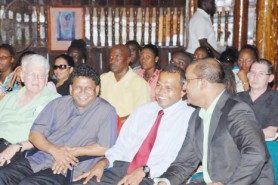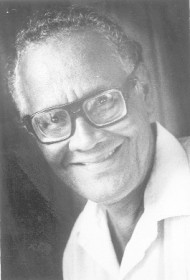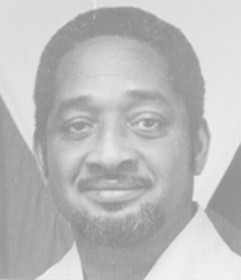Book lovers who expected that some sort of local publishing house would have been launched last February must be wondering still about the significance of the recent ceremony at the Umana Yana.

The Government, through the Ministry of Culture, Youth and Sport and in collaboration with Professor Dabydeen and Dr Ian Mc Donald, launched several reprinted Guyanese novels on February 26 this year. The books which have been released so far have been referred to as ‘classics’ in the sense that they were all written a long time ago.
The titles –Sir Walter Ralegh’s The Discoverie of Guiana; Theophilus Richmond’s The First Crossing; John Edward-Jenkins’s The Coolie, His Rights and Wrongs; Roy Heath’s The Shadow Bride; Robert Grieve’s The Asylum Journal (2 volumes); Egbert Martin’s Selected Poems; Cecil Clementi’s The Chinese in British Guiana; Martin Carter’s Selected Poems/ Poesías Ecogidas; Norman Cameron’s Anthology of Guianese Poetry, 1831-1931 and Charles Barrington Brown’s Canoe and Camp Life in British Guiana – have all been reprinted in the United Kingdom, not in Guyana or even the Caribbean.

The Government Information Agency reported that President Bharrat Jagdeo had given a committment to allocate US$100,000 annually towards the project which was expected to eventuate in “the first publishing house in the Caribbean.” This commitment was made spontaneously by the President when he attended a literary symposium during CARIFESTA X in August 2008 at which well-known literati – including Dereck Walcott and Earl Lovelace – were present. It was they who suggested that ‘a Caribbean publishing house’ would be an institution that would further unite the Caribbean.
The government turned to Guyana’s United Kingdom-based Ambassador-at-large and permanent representative to the United Nations Educational, Scientific and Cultural Organisation Professor David Dabydeen who was appointed ‘editor’ of the ‘Press.’ Professor Dabydeen confirmed that he was willing to continue in the capacity as editor for the next two or three years. As yet, however, there has been neither an indication that an assistant editor has been appointed to understudy him nor that a local office has been identified to guarantee continuity of the project on Guyanese soil.
Overseas-based Dereck Walcott, Pauline Melville and Earl Lovelace have also been installed as members of the editorial board and Dr Ian Mc Donald has been described as ‘consulting editor.’ The ‘Press’ is entirely a Government of Guyana enterprise that has been brought under the ambit of the Ministry of Culture Youth and Sport.
The President gave assurances of his continued support for the ‘Press’ and Minister of Culture, Youth and Sport, Dr. Frank Anthony promised that, having seen the quality of the first books in the series, resources would be provided to publish another dozen. Professor Dabydeen had pointed out that after being created in May last year, the ‘Press’ was able to reprint 11 volumes within a mere five months.
Professor Dabydeen expressed the opinion of some Caribbean writers who felt that for too long they have been subjected to the “imperialistic process where the raw material of their imagination had to be sent to London to be converted into a book and then returned to them at a high price.” He felt that “The Caribbean Publishing House is meant to address these issues…if we are to be truly independent we can establish a publishing house…that could be something of excellence.”
It would be pure fiction to state that anything has changed as local raw material is still being sent to London to be converted into books to be returned to Georgetown at a high price. According to the GINA report, Professor Dabydeen gave the impression that “the press would provide jobs while increasing the intellectual capacity as well as the printing capacity in Guyana.” Nothing of the sort has happened so far. Local intellectual capacity and printing expertise have been effectively sidelined under the present arrangements.

Dabydeen explained that, although the Press at present was engaged in reprinting works which were part of the ‘Guyana Classics Series,’ the intention was to publish fresh works written by local writers. When this would happen is anyone’s guess. He insisted further, that one of the main aims of the publishing house was to develop an interest in creative writing among the youths of the Caribbean, especially those in Guyana. Noting that in the past there had been limited opportunities for emerging Guyanese writers to have their work published, he expected that this would change with the establishment of the Caribbean of the ‘Press.’
The entire fantastic process so far – from the surprise August 2008 announcement, to the mysterious appointments of the editorial board, selection of texts, determination of the location for printing to the February 2010 launching ceremony – has left the local literary fraternity lost for words.
It would be fantasy also to claimt that the project has broken new ground. Book publishing in Guyana, of course, is not novel and it would be dishonest to discountenance the decades-long tradition of local publishing of a high quality. Book-publishing in most cases in Guyana, has been done successfully by established printeries. That explains why, throughout Guyana’s history, the newspaper presses took the lead in publishing.
The business of republishing Guyanese ‘classics’ was already accomplished successfully in the 1940s, for example. Eighteen titles in the Daily Chronicle’s “Guiana Edition of Reprints and Original Works Dealing with All Phases of Life in British Guiana” were edited by Vincent Roth and published between 1942 and 1948. Some of the more outstanding – Henry Bolingbroke’s A Voyage to the Demerary; Adriaan van Berkel’s Travels in South America; Vincent Roth’s Notes on Animal Life in British Guiana; George Pinckard’s Letters from Guiana; Edwin Wallbridge’s The Demerara Martyr; Peter Ruhomon’s Centenary History of the East Indians in British Guiana; Richard Schomburgk’s Travels in British Guiana; George Giglioli’s Amerindians of Highlands and Savannahs of British Guiana; Henry Kirke’s Twenty-Five Years in British Guiana – are perennial favourites. There are others.
The Argosy Company Limited famously published A R F Webber’s Centenary History and Handbook of British Guiana, James Rodway’s The Story of Georgetown and several other handbooks. Over the years, that company also published the celebrated Kyk-Over-Al literary journal. The New Guyana Company, publishers of the Mirror newspaper, published Ashton Chase’s A History of Trade Unionism in Guyana. Norman Cameron’s phenomenal half-century long literary career was marked by over thirty, largely local, self-published works that included The Evolution of the Negro.
Several publishing houses mushroomed in the post-Independence period. Some outstanding products of the nascent publishing industry were Walter Rodney’s Guyanese Sugar Plantations in the Late Nineteenth Century by Release Publishers; Blanche Duke’s A History of the Anglican Church in Guyana, Martin Carter’s Selected Poems and Andrew Morrison’s Justice: The Struggle for Democracy in Guyana, 1952-1992 by Red Thread Women’s Press; John Bennett’s and Richard Hart’s Kabethechino: A Correspondence on Arawak by Demerara Publishers; Winston Mc Gowan’s Themes in African-Guyanese History and Alvin Thompson’s A Documentary History of Slavery in Berbice, 1796-1834 by Free Press and Anna Benjamin’s Freedom of Expression and the Birth of Stabroek News and Lloyd Searwar’s Guyana and the World by Guyana Publications Inc. There have been many more books, of course.
There has been no shortage of local talent or interest in publishing. Over the past twenty years, technical expertise in printing has also been measurably enhanced. The local market, however has been unkind to local writers who, like other artists, artistes and world-class sportsmen especially cricketers have been obliged to seek support overseas in order to survive.
With its access to a wider and richer market, Peepal Tree Press of Leeds in the United Kingdom established itself as the publisher of more titles by Guyanese writers than any other publishing house in history. Dale Bisnauth’s The Settlement of Indians in Guyana, 1890-1930; Harischandra Khemraj’s Cosmic Dance; Narmala Shewcharan’s Tomorrow is Another Day; Ryhaan Shah’s A Silent Life and scores of other titles testify to the vitality of local talent and the necessity of publishers’ access to international markets to make the business successful.
The government itself has evinced little enthusiasm to produce its most prestigious books locally. This recent ‘Caribbean Publishing House’ project is evidence of this disdain. When it was ready to launch the first “official souvenir” book – Guyana – to showcase the country in July 2006, it turned to Arif Ali’s United Kingdom-based company known as Hansib to get the job done. Lokesh Singh’s St Lucia-based Advertising and Marketing Services Ltd, similarly, was given responsibility for publishing the country’s glossy “official” tourist guide – Explore Guyana.
Last year, on the other hand, several Amerindian dictionaries were published more obscurely as part of an Inter-American Development Bank-funded project. Director of Regional Health Services Dr Narine Singh presented the dictionaries – Short Dictionary of the Warao Language; Twenty-eight Lessons in Loko; Arawak-English Dictionary; Short Grammar and Dictionary of the Akawio and Arekuna Language and, Scholar’s Dictionary and Grammar of the Wapishana language – to Ms Jenny Wishart, the Administrator of the Walter Roth Museum of Anthropology to be distributed to Amerindian communities.
The project, started three years ago by the Health Sector Development Unit of the Ministry of Health, should contribute to efforts to preserve and educate the public about the unique languages of the Amerindian people of Guyana.
There is no mystery to the art of publishing books in Guyana. All that it requires is a small skilled group that has responsibility for the entire process of bringing books into existence – from identifying the talent, overseeing writing, editing and illustrating the texts and arranging for printing and marketing of the final products. Professor Dabydeen himself said as much. He suggested that the publishing house did not require elaborate staffing which could consist merely of an editor, copy editor, secretary and a driver. He also expressed the view that the printing of the books could be done locally although there has been no effort to make that a reality. What a pity!
It was Prime Minister Forbes Burnham, who – addressing the Caribbean Writers and Artists Conference held in Georgetown as part of Guyana’s Independence celebrations on May 30, 1966 – kept the book-publishing ball rolling. He asked the literati for ideas “on the practicability of a publishing company for the region to help artists express themselves neither in chauvinism nor in the insularity that reflected colonial rule but to show that we were on a plateau with other free peoples.” It was on that occasion that he also announced the intention to host a Caribbean Arts Festival to “help to foster and develop a Caribbean personality.”
The government did embark on publishing through its Materials Production Unit located in the Ministry of Education. The Unit was transferred to the Guyana National Service Publishing Centre in the mid-1970s. Printing was done at the state-owned Guyana National Printers Ltd. Former Director of Culture Arthur Seymour, writing in the UNESCO study Cultural Policy in Guyana over thirty years ago, was able to point out that several government agencies were “engaged in the preparation and printing of various types of promotional material and discussions are under way to establish a coordinated programme of printing which may lead to the establishment of a national publishing agency.”
The need for a national or regional publishing house was reinforced repeatedly after the introduction of the bi-annual Guyana Prize for Literature. The Guyana Prize, started in 1987 with the aim of promoting the development of local literature, aims at fostering the recognition of the creative writing of Guyanese. It also seeks to stimulate interest in and provide encouragement for the development of creative writing among Guyanese in particular.
The ‘Prize’ has been only a qualified success, plagued by anaemic local response that is a symptom of deficiencies in the local publishing industry. The cure for the disorder should be to build the capacity, rather than bypass, local publishers. It became evident that foreign-based writers who had access to established publishing houses and had the benefit of the advice of experienced editors and readers easily swept away the prizes. Some locals, with more zeal than skill, still submit poorly edited and poorly printed texts.
The government has made a bold step but in the wrong direction. By working together with local printers and publishers and developing talent through local book fairs and workshops for writers and illustrators, it could establish the basis of a real home-based publishing industry. The talent has always been here. The political will has not




